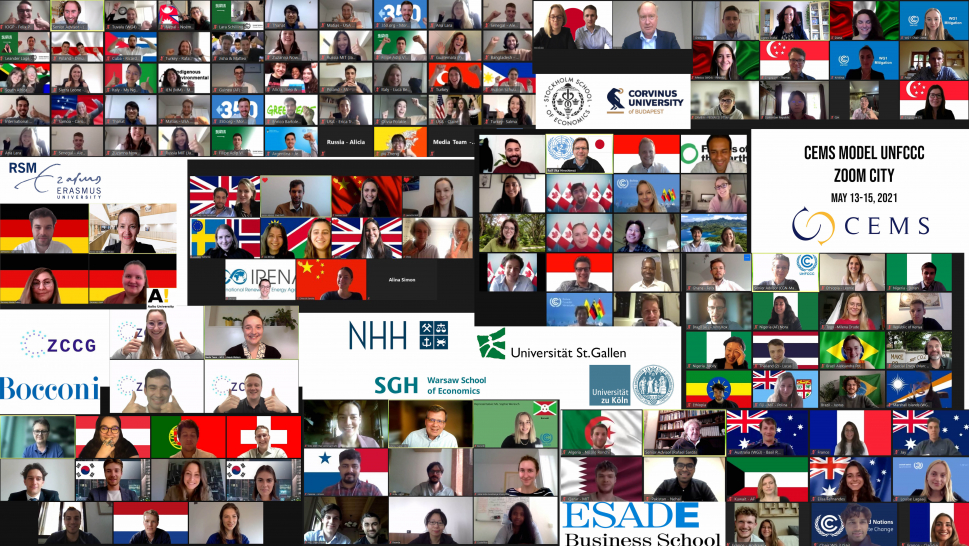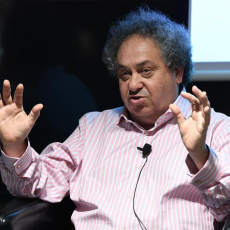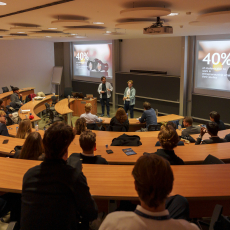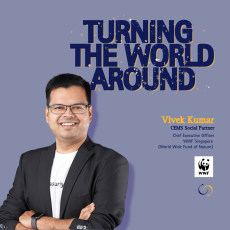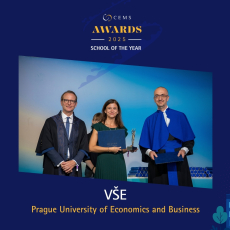Concrete solutions embedded in real life
All countries have pledged to make no new investments in coal from 2025. Developed countries will achieve climate neutrality by 2045 at the latest. By 2023, we will reach a global peaking of greenhouse gas emissions. And the annual contribution to the Green Climate Fund got reassessed to increase to US$ 200 billion by 2025, while an ambitious loss and damage fund has been created.
These are some of the key elements among agreement delivered by the Model United Nations Framework Convention on Climate Change on May 15.
Of course, the actual UN Climate Change Conference, COP 26, plays out in Glasgow in the first part of November this year, when delegates from 197 nations will have the thorny task of negotiating an emissions roadmap in line with 2030’s aggressive targets.
And as 160 CEMS students from 10 universities around the globe discovered this month, they won’t have it easy.
Played out in Zoom City
The CEMS Model UNFCCC roleplay simulation is now in its 13th edition. May’s event was hosted by Zoom City – the second virtual event hosted via Zoom since the start of the pandemic in 2020.
The UNFCCC roleplay has grown over the last decade in scope, ambition and popularity says this year’s programme manager, Pascal Vuichard, in tandem with increasing awareness of the urgency of addressing climate change – and a significant upswing in enthusiasm from students to be “part of the solution.”
“This year’s simulation was maybe the most successful UNFCCC event so far, with students telling us overwhelmingly that they feel far more motivated to pursue climate-positive careers as a consequence of taking part.”
Considered one of the largest and most innovative, cross-institutional role plays in business education globally, the CEMS Model UNFCCC is an elective course open to students and business schools enrolled in the CEMS alliance. And it’s also one of the most ambitious.
Preparation is key
Preparation for the simulation begins weeks beforehand, with modules on climate science, climate policy, the role of business in climate change and negotiation. The goal is two-fold, says Vuichard, who manages the Executive Education Program in Renewable Energy Management at St. Gallen: to expose students to the complexities that surround the challenges posed, while simultaneously making them aware of the “sheer intractability” that dogs multi-party negotiations.
“The UNFCCC course is a lot to manage and it’s a lot for students to digest. The teaching and preparation stage spans multiple disciplines, from science to policy to the business concepts and interpersonal skills – influence and negotiation. At its core, it’s geared to opening students’ eyes to the complexity of this enormous challenge, and the complexity of the solutions that need to be devised. That, and building a palpable sense of awareness and urgency around what is, in reality, the greatest existential threat to our wellbeing on this planet.”
Offering a different perspective

Participating students are assigned countries (not their own) to represent and roles that map to the real-life profiles of COP negotiators. Four working groups are created that focus on critical areas. This year, these were mitigation, market mechanism, adaptation & finance and climate refugees & loss and damage. Additional roles included those of industry representatives from fossil and renewables spaces as well as NGOs, with each student (or distinguished delegate as it is called in formal negotiating language) required to prepare a negotiating position mapping to their assigned organisation and country followed by the negotiation of the draft agreements proposed by each working group.
“Giving them a country or organisation that doesn’t mirror their nationality or, necessarily, their interests and allegiance is a way of encouraging students out of their comfort zone and to look at the problem in all of its dimensions,” says Vuichard. “The broaden their knowledge and perspective while learning to advocate from multiple viewpoints.”
It is impressive, he says, how students “stick to their roles” throughout the simulation; an indication of the depth of immersion and the experiential quality of the learning.
“We see evidence of real behavioural shifts among students coming out of the CEMS Model UNFCCC course, which is an outcome that is much harder to achieve in the traditional classroom setting. I think this is a function of an experience that is lived, in a sense, rather than simply learned. Students get very real, live and hands-on experience of just how very difficult it is to negotiate multi-party agreements – as well as a sense that these kinds of problems cannot simply be left in the hands of international negotiators to resolve.”
An imperative for the entire world
There is a greater need than ever, says Vuichard, for upcoming, next-generation leaders with this kind of embedded understanding and awareness to tackle the increasingly urgent challenges to our environment. In 2021, an iceberg almost half the size of Puerto Rico split from Antarctica, focusing the world’s media on the issue of ice loss there, and also in Greenland where consensus is growing that the ice sheet is close to reaching a tipping point.
“What is encouraging is the feedback we collated from students after the simulation,” says Vuichard. “More than 80% of the participants reported that they came away feeling far more motivated to pursue climate-positive careers, while 98% said they were more convinced about the acute importance of addressing climate needs.”
Interestingly, only 37% of the students reported feeling more confident about the actual UNFCCC’s capacity to achieve ambitious enough agreements – an indication of their growing understanding of the difficulties facing real-world negotiations, says Vuichard; and an interesting message to send to delegates assembling in Glasgow later this year.
“We will be disseminating the findings, agreements and recommendations of the CEMS Model UNFCCC to the COP and inviting them to look at what our students negotiated, and at their ideas and beliefs emerging from the experience. We hope that this can play however small a role in helping to spur collective awareness around the urgency of tackling climate change when they meet in November.”
